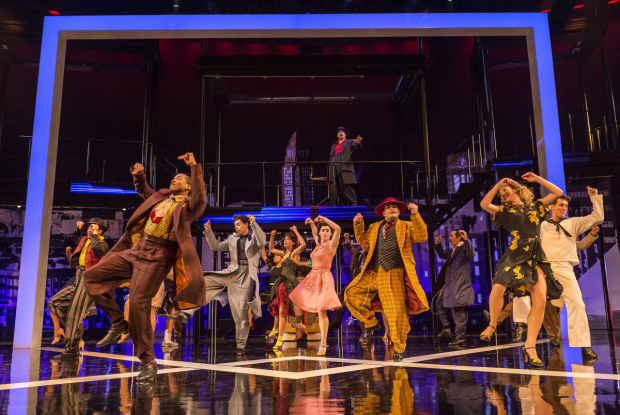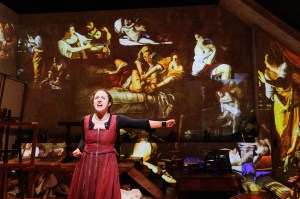Zoot Suit
The legendary play returns to where it all began 38 years ago, the Mark Taper Forum.

(© Craig Schwartz)
Zoot Suit could not be more timely. Many Americans, whether minorities or not, are feeling increasingly disenfranchised and abused by the system. Zoot Suit focuses on a period of time long ago, but not very different from today. While the revival at the Mark Taper Forum should sting, this production, directed by creator Luis Valdez, feels dated and superficial, more a product of its time than timely.
In 1942, when the United States and allied forces fought fascism and unimaginable evil, the land of the free did not exactly have clean hands. Innocent U.S. citizens were locked in internment camps purely because of their ethnicity, and the justice system betrayed minorities, stripping them of their constitutional rights. One glaring example was the Sleepy Lagoon Murder, where a youthful Mexican-American gang was railroaded for murder despite a lack of evidence. The trial became a circus with the judge allowing the prosecution to mischaracterize evidence and punish witnesses for telling the truth.
Valdez's play about that event, which opened at the Mark Taper in 1979 before transferring to Broadway, mixes social realism with allegory and the elements of a musical. Though the script tells the straightforward facts of the trial, a narrator, El Pachuco (Demian Bichir) acts as both Greek chorus and the devil sitting on the shoulder of persecuted protagonist Henry Reyna (Matias Ponce), taunting him. Also breaking the realism, El Pachuco and his backups sing and dance popular swing numbers including "Zoot Suit Boogie" by Lalo Guerrero and "In the Mood" by Glenn Miller Orchestra.
The story line itself doesn't dig deep enough into the characterizations. Reyna and his gang were in the wrong place at the wrong time and became scapegoats for rising racial tension at a time when the U.S. was supposed to be protecting minorities from fascism. The script itself isn't insightful enough to make audiences understand the outrageous irony of it all. The courts are corrupt, with the judge, prosecution, and press colluding to stamp out the fear of youth gangs, but they're portrayed so outrageously, they become the stereotype villainous authority figures. The trial sets off a riot between the Mexican-American community and naval officers, but other than one metaphorical sequence, where a group of militia strips down El Pachuco into the beaten-down image of Christ, most of the events are only suggested.
Valdez' cast, hampered by his sloppy direction, never rises above the material. Bichir is difficult to understand. He garbles his words utilizing a stylized accent and doesn't convey enough of what he is meant to symbolize. He becomes a hodgepodge: a narrator, a conscience, a nay-sayer, but instead of his signifying universality, his importance in the piece becomes a ploy, not an enhancement. The other actors feel as if they're playing types rather than fleshed-out characters. Brian Abraham never goes beyond the cliché of the beleaguered but optimistic lawyer of the deprived. Tiffany Dupont plays all the typical notes as the Communist reporter invested in the common man. Ponce is too removed as the gang leader so much so that his plight comes across as exclusively personal rather than representative of the communal oppression. The sustained ferociousness of Ponce's portrayal prevents the audience from developing any sympathy for the character, or the terrible injustice his character endured.
Adding to the unevenness of the cast, the songs feel unrehearsed and uncertain. During several numbers with Bichir and his backup singers, they're imprecise, ending notes haphazardly and separately. Fortunately, the dancing, choreographed by Maria Torres, is lively and features swing moves like the jitterbug, Charleston, and Lindy hop. The dancers capture not only the moves, but the youthful enthusiasm inherent in the swing movement. Ann Closs-Farley's costumes are vibrant and slick, complete with the famous zoot suits that represented European opulence, and led to hostility from the American establishment. Also captured nicely are the rockabilly hairstyles popular during the war.
Zoot Suit is reminiscent of The Scottsboro Boys, in which Kander and Ebb use the confines of the minstrel show to illustrate the belittling of a race, but that musical mightily indicted all of American society in the telling of this individual story. Zoot Suit attempts to be epic but instead feels dated and ordinary when the subject matter should feel more like a time bomb about to explode.











